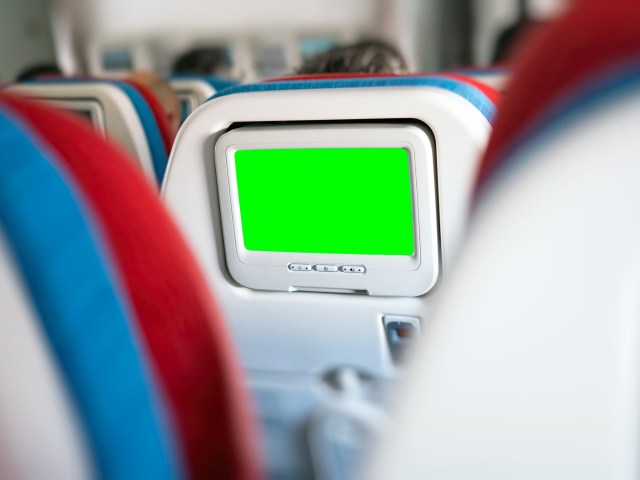Boarding a flight is the kickoff to a great vacation, but poor airplane etiquette can quickly ruin the experience. There are some unspoken rules when traveling 30,000 feet up — use headphones, don’t turn on the reading light during a red-eye, and so on — but there is one hotly debated topic that passengers can’t seem to agree on: seat reclining. Are you rude if you do it? Are you rude if you ask the person in front of you not to recline their seat? Flight attendants and travel experts have weighed in — check out their advice on the controversial topic below.
Disappearing Legroom

It’s a fact: The space between airline seats is shrinking, as are the seats themselves. As passengers feel increasingly cramped on commercial flights, the debate over reclining continues to heat up. In a little over a decade, the average pitch (the distance between the back of one seat to the back of another) on airplanes has decreased by 4 inches. This reduced legroom allows airlines to fit more seats in the cabin, but it comes at a cost. Frustrated passengers can’t recline, move around, or sit as comfortably as they once did.
The Verdict: Should You Recline?

Aside from during takeoff and landing, reclining your airplane seat is always allowed — but whether you should recline is up for discussion. This gray area causes many in-air arguments, much to the dismay of weary flight attendants. “Besides lack of Wi-Fi or a broken entertainment system, flight attendants hear more complaints about reclined seats than anything else,” U.S. flight attendant and author Heather Poole says. Like many flight attendants, Poole acknowledges that passengers can technically recline their seats at any time (except during takeoff and landing, per FAA regulations) because it is part of the seat function they pay for. However, there are best practices to be courteous to others — and there are times when it may be inappropriate to recline.
Travel Channel host and travel expert Samantha Brown weighed in on the unspoken rules of airplane seating, explaining that reclining depends on the situation. “Do I recline? Yes and no.” She explained, “I do not recline if the trip is under three hours. Over three hours, I want to get comfortable. So yes, I am going to recline.” In addition to flight time, there are other important considerations when deciding to recline, including awareness of passengers around you.
Sara Nelson, International President of the Association of Flight Attendants-CWA, AFL-CIO, also shared her thoughts. Although she doesn’t recline while flying, she understands that many passengers do. “If you really want to do it, at least check behind you. Make sure you’re not going to be spilling somebody’s coffee on them,” she suggests. The takeaway from this expert advice reveals that reclining can be OK if you pay attention to your neighbors and surroundings.
Always Ask First

As long as airline seats recline, passengers will recline them. However, there are ways to help ease the tension while reclining to ensure everyone is comfortable during the flight. One of the most common recommendations from flight attendants, etiquette experts, and travel gurus is to simply ask the passenger behind you before hitting that little silver button. This is particularly important during short flights or on small planes where people are less likely to expect you to recline. (On the contrary, it’s almost always expected that a passenger will recline on a long-haul or red-eye.)
If you get the green light from your neighbor, go ahead and recline, but do so slowly to avoid causing problems for the person behind you. Too often, an unlucky passenger has ended up with a lap full of ginger ale because the person in front of them lowered their seat too quickly. Avoid reclining during meal or drink services when other passengers will likely have their tray tables out and full. Not only does this cause spills, but many flight attendants have witnessed broken laptops, cracked tablets, and other unfortunate accidents from seats reclining without warning.
Flight Attendants Can Help

If you and your neighbor disagree about reclining, ask for a flight attendant. After all, they’re trained to keep passengers safe and comfortable. For example, if you’d like to recline your seat on a long flight to help ease back pain, but the person behind you doesn’t want you to recline because they’re working on their laptop, you might need help fixing the situation. It’s possible that the flight attendant can move one of you to an empty seat to solve the issue. It’s never worth arguing with a fellow passenger, as is often seen in viral videos on social media.
The Bottom Line

Ultimately, your fellow passengers aren’t the problem — cramped airline seating is the culprit. So, try to be courteous and communicate calmly to solve problems. “Really, this isn’t a war on reclined seats. This is about space, and most airlines give you the option to purchase more space. So, remember that next time you’re searching for the cheapest flight,” Poole says. It might be worth shopping around for more space in an exit row or premium economy if this is important to you. Remember, there are no rules against reclining your seat (unless you are taking off or landing), so it is up to you to decide when it is appropriate for you and those behind you.
More from our network
Daily Passport is part of Inbox Studio, which publishes content that uplifts, informs, and inspires.
















